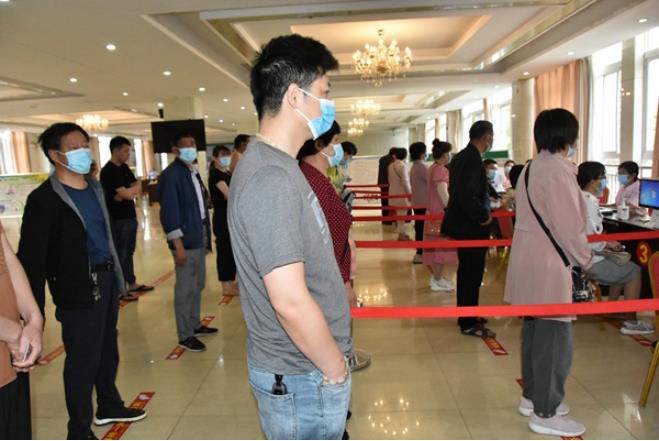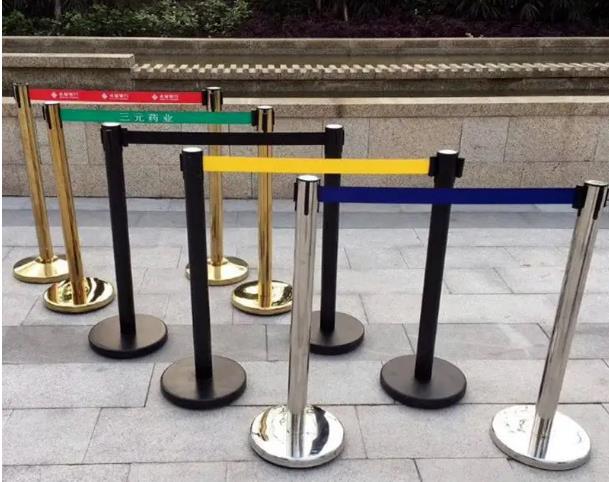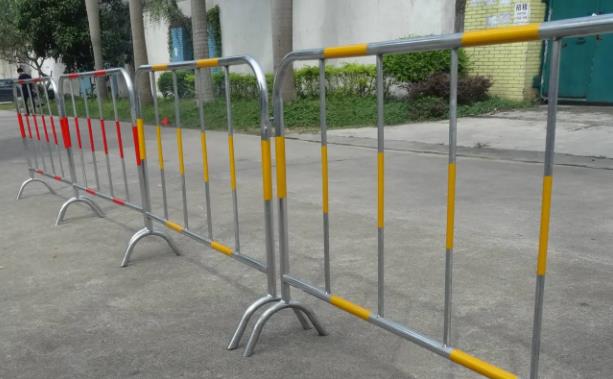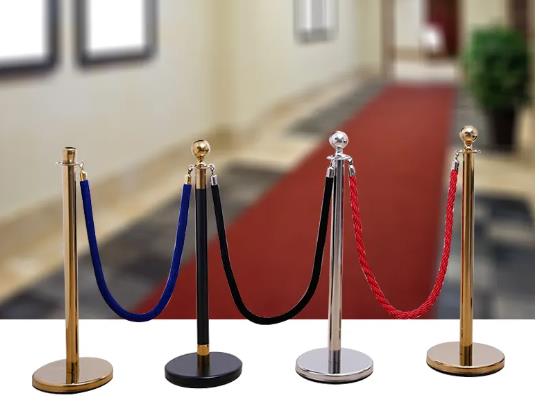Crowd control is becoming an increasingly
important consideration for businesses and events around the world. As people
gather in larger numbers, it's essential to ensure that pedestrian traffic is
managed efficiently and safely. This is where stanchions come into play.
Stanchions are vertical poles or posts that are used to create a physical
barrier or queue management system.

Stanchions are versatile and can be made
from a variety of materials, including metal, plastic, and even wood. The most
popular types of stanchions are retractable belt barriers, post and rope
barriers, and barricades. Retractable belt barriers are stanchions with a
retractable belt that extends from the top of one post to the top of another,
creating a physical barrier. Post and rope barriers consist of vertical posts
with ropes connecting them, creating a visual barrier. Barricades are physical
barriers that are often used to control traffic flow or create a safety
barrier.
One of the most significant advantages of
using stanchions is their ability to manage pedestrian traffic. Stanchions help
create a visual barrier, which can direct people to specific areas and ensure
social distancing measures are maintained. Additionally, stanchions can help
organize lines, making it easier for people to queue for tickets, food, or
other services. This not only makes it easier for customers but also ensures
that businesses can manage their flow of customers more efficiently.
Stanchions are also an excellent way to
ensure safety in crowded areas. For example, barricades can be used to create a
safety barrier around construction sites or hazardous areas. This can help
prevent accidents and keep both workers and the public safe.

However, stanchions are not without their
disadvantages. Some types of stanchions can be expensive, and others may
require more space than others. Additionally, stanchions may not be suitable
for all types of events or businesses. It's essential to consider the space you
need to manage, the type of event or business, and your budget when choosing
the right stanchion for your needs.
Despite their disadvantages, stanchions are
an effective and versatile tool for managing crowds and ensuring social
distancing. They are a great solution for organizing events, managing
businesses, and controlling pedestrian traffic. By understanding the different
types of stanchions available and their advantages and disadvantages, consumers
can make an informed decision about which type is right for their needs.
Some other types of stanchions include:
- Rope stanchions
- Chain stanchions
- Heavy-duty stanchions
- Post and panel stanchions
- Classic stanchions
- Portable stanchions
- Pedestrian barricades
- Traffic cones and barriers
- Tensabarriers
- Security stanchions
Each of these stanchions is designed for
specific purposes and can be used in a variety of situations. Rope stanchions
are often used in upscale events and can be customized to match the decor of
the venue. Chain stanchions are more robust and can be used in outdoor areas or
construction sites. Heavy-duty stanchions are designed to withstand heavy use
and can be used in high-traffic areas. Post and panel stanchions are often used
to create a permanent barrier in public areas. Classic stanchions are the most
common type of stanchion and can be used in a variety of situations. Portable
stanchions are lightweight and easy to move, making them perfect for events and
temporary setups. Pedestrian barricades are designed to control foot traffic in
outdoor areas, while traffic cones and barriers are used to direct vehicular
traffic. Tensabarriers are retractable belt barriers that are often used in
public places, such as airports and train stations. Finally, security
stanchions are often used in areas where security。
Stanchions are a versatile and effective
way to manage pedestrian traffic in a variety of settings. They can be used to
organize queues, direct foot traffic, create safety barriers, and more.
However, with so many different types of stanchions available, it can be
challenging to determine which type is right for your needs. In this article,
we'll explore the different types of stanchions available, their advantages and
disadvantages, and how to choose the right stanchion for your needs.
Types of Stanchions
Retractable belt barriers are one of the most popular types of stanchions. They consist of a vertical post with a retractable belt that extends from the top of one post to the top of another post, creating a physical barrier. These stanchions are often used to organize queues or direct foot traffic in a variety of settings, including airports, museums, and theme parks. The retractable belts can be customized with a logo or message, making them an effective marketing tool.

Advantages: Retractable belt barriers are versatile and can be used in a variety of settings. They are easy to set up and take down, making them perfect for temporary events. They are also customizable, allowing businesses to promote their brand or message.
Disadvantages: Retractable belt barriers
can be expensive, and retractable belts can become tangled or damaged over
time.
2. Post and Rope Barriers:
Post and rope barriers consist of vertical posts with ropes connecting them, creating a visual barrier. These stanchions are often used in upscale settings, such as theaters or museums, to create an elegant barrier. Post and rope barriers are also commonly used in outdoor settings, such as weddings or festivals.

Advantages: Post and rope barriers are elegant and sophisticated, making them perfect for upscale events. They are also customizable, with different rope colors and post designs available.
Disadvantages: Post and rope barriers
require more space than other types of stanchions, and the ropes can become
tangled or damaged over time.
Rope stanchions are similar to post and rope barriers but consist of a single vertical post with a rope extending from the top. These stanchions are often used in upscale settings, such as theaters or museums.

Advantages: Rope stanchions are elegant and sophisticated, making them perfect for upscale events. They are also customizable, with different rope colors and post designs available.
Disadvantages: Rope stanchions require more
space than other types of stanchions
Stanchions are a crucial tool for managing crowds and ensuring safety in various settings, from events and concerts to retail stores and public areas. They offer a flexible and affordable way to manage pedestrian traffic and create a physical barrier to keep people safe.
When it comes to choosing the right
stanchion for your needs, there are many factors to consider. Some of the most
important factors include the type of event or business, the space you need to
manage, the number of people you expect to accommodate, and your budget.
If you're hosting an event, you'll need to consider the type of crowd you'll be dealing with and the layout of the venue. For example, if you're organizing a concert, you may need to use heavy-duty stanchions that can withstand the weight of large crowds. If you're hosting a corporate event, you may want to consider using rope stanchions that match the decor of the venue and create an upscale atmosphere.
In retail settings, stanchions are often
used to organize lines and manage pedestrian traffic in high-traffic areas. For
example, they can be used to create a queue for checkout or to direct customers
to specific areas of the store. In this case, you may want to consider using
portable stanchions that can be easily moved and stored when not in use.
One of the most popular types of stanchions
is the retractable belt barrier. These stanchions are incredibly versatile and
can be used in a wide range of settings, from airports and train stations to
retail stores and events. They are easy to set up and can be customized with a
variety of belt colors and styles to match your needs.
Securina supplying a variety of stanchions with different cost, welcome send email to info@securinadetection to get newly price list.